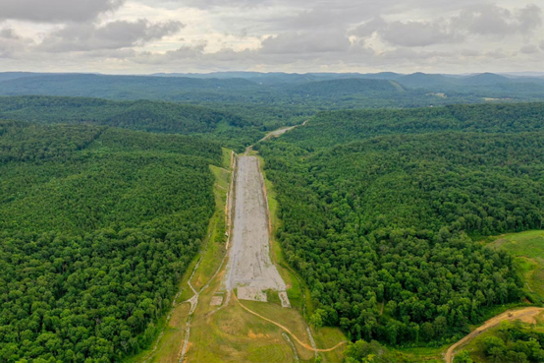Reconciliation and Infrastructure Bills Would Generate Massive Carbon Emissions From Logging and Highways
Chad Hanson, Ph.D. and John Talberth, Ph.D. • September 28, 2021
As Congress accelerates work to pass two massive new spending bills – the budget Reconciliation ($3.5 trillion) and Infrastructure ($1.2 trillion) packages – lawmakers need to do the math to ensure that money is not thrown to programs that increase greenhouse gas pollution and reduce our ability to overcome the climate crisis. After all, one of the key selling points for each is their claimed climate benefits. Proponents of the Reconciliation package, for example, assert that some clean energy measures included in the bill, along with some in the Infrastructure package, would slash US carbon emissions by 880 million metric tons (0.88 gigatons) of annual CO2 emissions by 2030. However, as discussed below, the very recent elimination of the Clean Energy Performance Program (CEPP) from the Reconciliation package lowers the annual CO2 emissions reduction to only 0.38 gigatons by 2030. Moreover, buried within both bills are expenditures that would take us even further in the opposite direction – among them, massive subsidies for logging and highways that come with a steep carbon footprint. In combination with the elimination of CEPP, these climate-harming aspects of the Reconciliation and Infrastructure packages would actually increase net annual CO2 emissions by 2030 relative to current levels.
When the House passed the Reconciliation package on September 13th, Big Timber celebrated. As they should. Of the $40 billion allocated for agriculture and forestry, over $22 billion is for line items that would subsidize logging, and associated carbon removal and emissions, on both public and private forestlands. Because most members of Congress have little experience with forestry, they were easy targets for the usual scientifically indefensible narratives telling us we need more logging to combat wildfires, improve forest health, and reduce emissions by storing carbon in wood products. The Forest Climate Working Group, whose members include notorious logging corporations like Green Diamond, Enviva and Rayonier, deceptively lauded the investment as “the most significant legislative action yet to leverage forests and forest products as a powerful nature-based solution to help combat climate change.”
"Giving logging's double whammy on climate change and climate resiliency, logging subsidies have no place in either the budget reconciliation or infrastructure packages. Congress should strike the offending line items and take a hard look at others that also raise climate red flags, like funding for new highways."
But the reality is that logging stimulated by this money will be a big step backward for efforts to curb carbon emissions and promote climate resiliency. While calculating the amount of new logging and associated carbon emissions from the spending bills requires some care, it is nonetheless tractable enough for Congress to do the homework before passing either measure. One relatively straightforward way is to ask how much logging would the $22 billion buy and from there calculate the volume produced (measured in thousand board feet) and associated emissions based on emissions factors (metric tons CO2 per thousand board feet) reported in existing studies. Another way is to consider the acres targeted for logging – 30 million in the Infrastructure bill alone and many millions more in the Reconciliation bill – and estimate emissions using reliable federal data on how much carbon would be removed by logging and how much would likely end up in the atmosphere.
A new report from John Muir Project and Center for Sustainable Economy employs both methods, and the results are disturbing. If passed, the Reconciliation and Infrastructure packages are likely to generate an additional 3 to 4 gigatons of CO2 pollution from logging over the next 10-15 years, as carbon now stored in trees would be lost and emitted into the atmosphere through the wood products life cycle and as newly logged areas give off rather than sequester carbon – an effect that can last ten to fifteen years after logging activities conclude. In terms of 2030 goals, this would take a big bite – 0.25 to 0.34 gigatons – out of the 0.38 gigaton CO2 emission reductions associated with remaining clean energy provisions in the bills (with CEPP eliminated) and would take us farther away from President Biden’s goal of a 50-52 percent reduction from 2005 levels in economy-wide net greenhouse gas pollution , actually causing an overall net increase in annual CO2 emissions of 80 million tons by 2030.
But emissions are just part of the story when it comes to logging and climate change. A consistent conclusion from many scientific studies approaching the issue from many directions is that heavily logged landscapes are far less resilient to the effects of climate change. They are more susceptible to wildfires, flooding, insects, disease, wind damage, heat waves, landslides and harmful algae blooms. These stressors are already on the rise due to climate change – logging makes the effects so much worse.
For example, in fire prone regions of the West, timber plantations burn hotter and faster than natural forests, and logging in general, including thinning, degrades the cool, moist microclimate that denser forests have, resulting in hotter, drier, and winder conditions that increase fire intensity, according to the largest scientific analysis ever conducted on this question. Logged areas produce far less water in the dry season and the waters that trickle out are more vulnerable to harmful algae blooms (HABs) because they’re hotter and laced with a cocktail of chemicals and fertilizers that fuel HAB growth. Hurricanes have a field day in heavily logged areas while real forests with a diversity of ages and tree sizes survive more intact.
Given logging’s double whammy on climate change and climate resiliency, logging subsidies have no place in either the budget Reconciliation or Infrastructure packages. Congress should strike the offending line items and take a hard look at others that also raise climate red flags, like funding for highways.
The current Infrastructure package passed by the Senate in August authorizes $110 billion for highways, roads, bridges and other major transportation projects. While the intent is to focus on the backlog of repairs needed to existing infrastructure, significant portions would be used for new roads or extra lanes – each of which has serious climate consequences by accommodating more traffic and catalyzing the conversion of farm and forestland to suburban sprawl. Case in point is the massive Birmingham Northern Beltline Project, which is being punched through some of the nation’s most productive forests and wetlands and which would be brought to completion if the Infrastructure bill is signed into law. With that money, 3,100 football fields’ worth of forestland would be paved over. But this project is just one of many the Infrastructure bill would support.

The current Infrastructure package passed by the Senate in August authorizes $110 billion for highways, roads, bridges and other major transportation projects. While the intent is to focus on the backlog of repairs needed to existing infrastructure, significant portions would be used for new roads or extra lanes – each of which has serious climate consequences by accommodating more traffic and catalyzing the conversion of farm and forestland to suburban sprawl. Case in point is the massive Birmingham Northern Beltline Project, which is being punched through some of the nation’s most productive forests and wetlands and which would be brought to completion if the Infrastructure bill is signed into law. With that money, 3,100 football fields’ worth of forestland would be paved over. But this project is just one of many the Infrastructure bill would support.
As reported by the Washington Post, in 2019, $19 billion – about a third of states’ capital spending on roads that year, went towards expanding the road network rather than addressing the maintenance backlog. Despite federal intentions, states retain the right to use transportation funding as they see fit and new highways often have a much higher political payoff than routine maintenance or repairs. So it could be expected that a third ($37 billion) of the $110 billion line item would be used to pay for new or expanded highways. At roughly $4 million per mile, that’s enough funding for over 9,250 miles of new pavement.
But what’s the climate cost? According to a useful analysis by Seattle’s Sightline Institute, each new mile of highway generates between 117,000 and 186,000 tons of CO2 associated with construction activities and new traffic even after deducting some carbon savings from less congestion. If the Infrastructure spending results in 9,250 miles of new roads, that’s a carbon price tag of another 1.1 to1.7 gigatons of CO2 (mid-range of 1.4 gigatons of CO2).
And, despite calls for elimination of all fossil fuel subsidies from the Biden Administration and many Congressional Democrats, the Reconciliation bill retains most fossil fuel subsidies. If these subsidies were eliminated, it would equate to a reduction in emissions of 0.18 gigatons of CO2-e in 2030.
Moreover, instead of increasing logging and associated carbon emissions, what if the Infrastructure and Reconciliation bills went the other direction? If the bills not only restored the CEPP, but also reduced annual US carbon emissions from logging by 50% by 2030 by defunding logging on public and private lands and initiating and funding a large-scale program of acquisition of private forestlands into protected public ownership from willing sellers, it would reduce CO2-e by an additional 0.36 gigatons in 2030, based on figures pertaining to current annual carbon emissions from logging in US forests, and adding 17% for CO2 emissions from transportation associated with logging.
As this analysis of the massive Reconciliation and Infrastructure bills suggest, blindly throwing money at federal programs is not a panacea for climate change. Instead, Congress should carefully consider federal investments by using a strict climate test that uses best available science and data to predict the net effects of any particular investment being considered. Even if it takes more time. The climate emergency does not afford us the latitude to take two steps forward and one or two back.
Read the report: Running Backwards: Logging provisions in the infrastructure and budget reconciliation packages would worsen the climate crisis and threaten public health.
Chad Hanson, Ph.D. is Executive Director and Principal Scientist of John Muir Project of Earth Island Institute. John Talberth, Ph.D. is President and Senior Economist for the Center for Sustainable Economy and Co-Director of the Forest Carbon Coalition.


